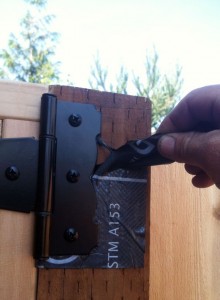ACQ treated lumber, corrosion and it’s causes.
Several years back environmental regulation mandated the removal of arsenic from the treatment of wood products, definitely a good thing. Heavy metals were being found in the soil beneath play equipment at schools and other sites. This posed a real challenge for wood product chemists and manufacturers, how to market a pressure treated wood without the usual chemical cocktail. The way they achieved this is by adding large amounts of copper to the formula, ACQ. Here’s the battery part, batteries are made possible by the placement of dissimilar metals in an electrolyte to create a current by the corrosion of the metals. The same thing happens when steel or zinc plated hardware and nails come in contact with the high level of copper in treated woods. There are specially coated hardware and stainless steel alternatives to most products you can use on a deck. If you use a standard metal component the level and rate of corrosion is shocking. literally in a couple of weeks a regular zinc plated hanger will look like the battery post on an old car, greenish fuzz and all. One area of particular concern is deck screws. the steel used for screws is less elastic than that of nails and the ACQ treatment causes them to become very brittle and in the case of composite decks which expand and contract slightly the fasteners are highly prone to breakage. Even the ACQ rated screws are not immune to this. I almost exclusively use stainless steel fasteners on my composite or cellular PVC decks and only use stainless nails on fences. Not only is stainless more corrosion resistant but, the steel is more elastic as well resisting the shearing caused by the deck movement. Stainless will cost more on the front end but, save you big in the end.

